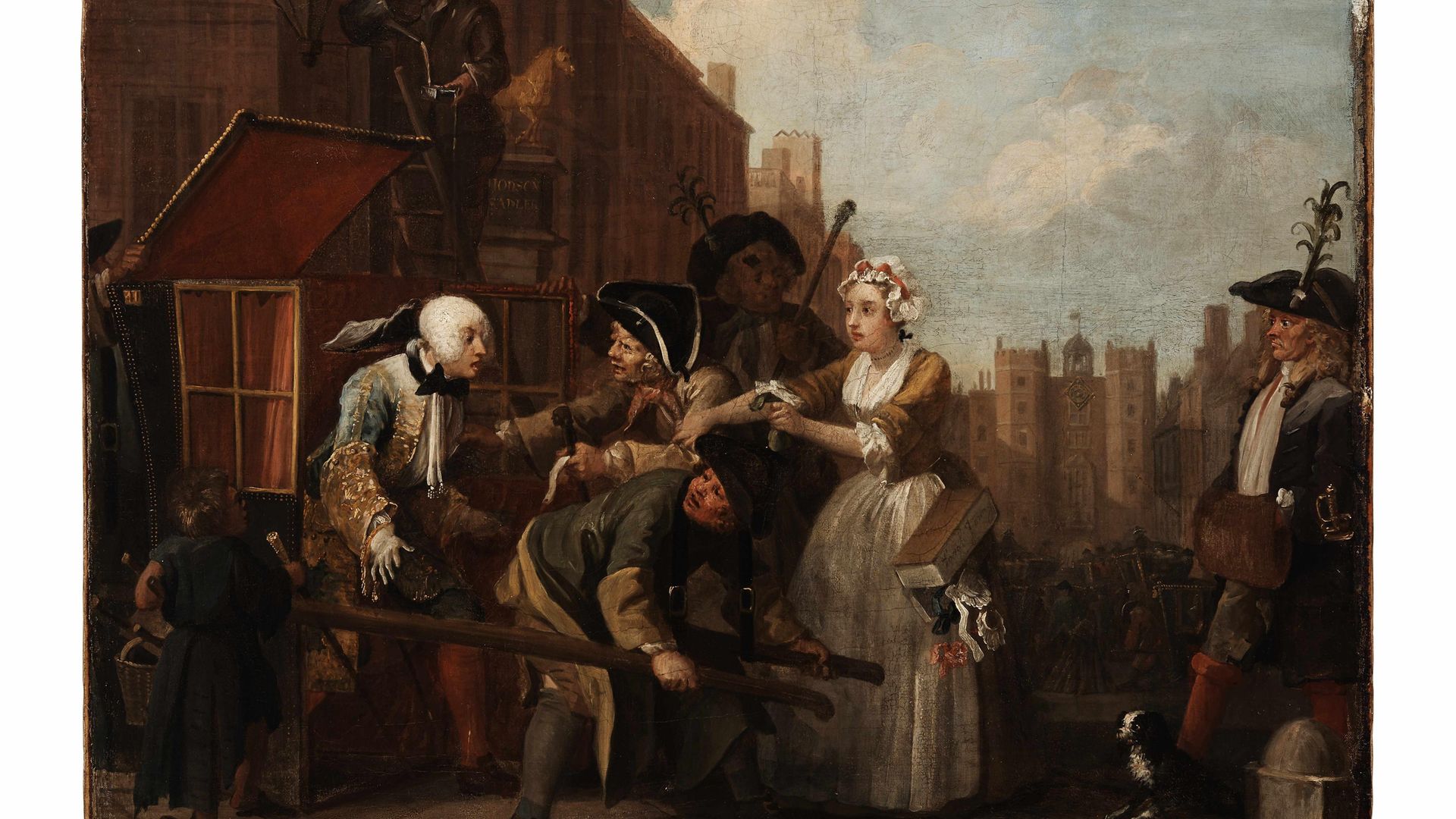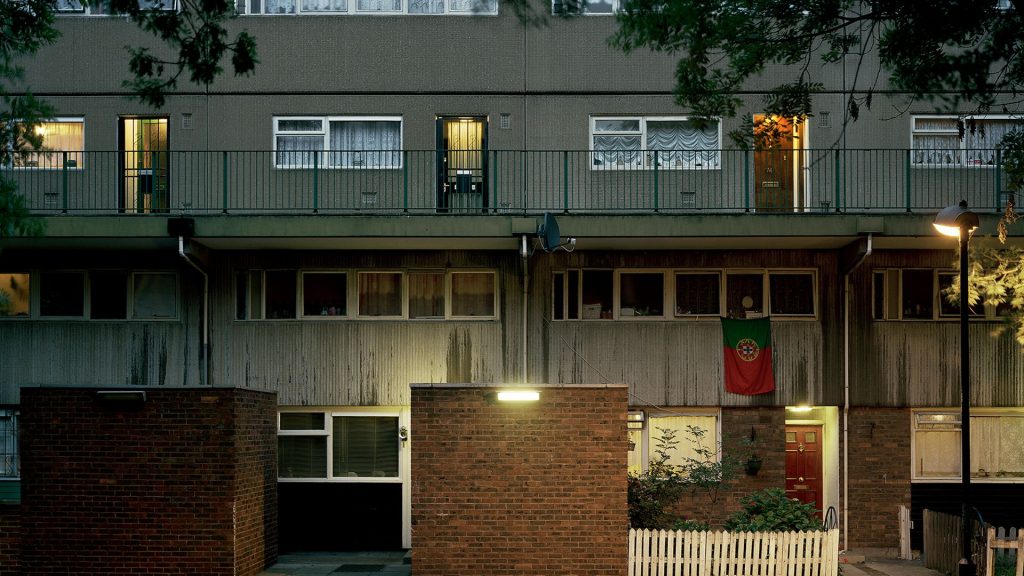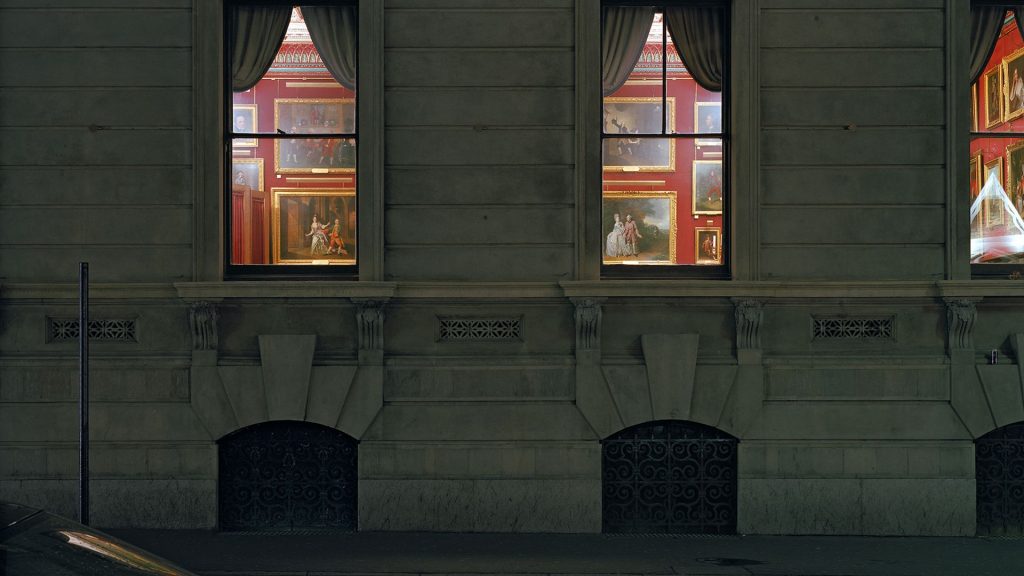
William Hogarth exposed the chaos, hypocrisy, corruption and pollution of the world around him. A new exhibition showcases his work and that of contemporary artists performing similar tasks in their own society.
The first image to greet the visitor to the exhibition, Hogarth: London Voices , London Lives is a photograph of a block of flats. Bleak, worn down by poverty and indifference.
So, not Hogarth but Heygate, a 1970s Brutalist development in south London which was finally pulled down in 2014 and replaced by another huge estate which has attracted the wallets of foreign investors and failed to provide as much ‘affordable’ housing as before.
It seems a counter-intuitive introduction given the exhibition title but the photograph’s apparent banality signals a nuanced decision by the gallery, Pitzhanger Manor in Ealing, West London, not to attempt to match William Hogarth’s uncompromising exposé of the frailties and conceits of society with contemporary examples.
It would be a challenge at the best of times to match the cynicism of Marriage A-la-Mode which illustrates the disastrous consequences of marrying for money rather than love, or the searing image of the drunken women in Gin Lane, letting her baby slip out of her impervious hands from the top of some stairs.
But today the challenge is maybe even greater given the relative shortage of satirists at work. Spitting Image is back but has lost its 1980s bite and there are a clutch of cartoonists such as the incomparable Peter Brookes on the Times, Gerald Scarfe in his heyday or artists such as Grayson Perry, Banksy perhaps, who have done their best to undermine the corrupt, the powerful and the absurd.
Maybe the Kissinger factor helped to render satire redundant. When the former US secretary of state in the Nixon administration won the Nobel peace prize in 1973, despite his promulgation of the Vietnam War, comedian Tom Lehrer quipped that satire had died.
Is it possible to satirise Donald “Stop the Count” Trump or Boris “Moonshot” Johnson, who has himself dismissed some of his own most controversial comments as “wholly satirical”? Hogarth, one suspects, would have found a way.
The work on show at Pitzhanger is The Rake’s Progress which tells the story of a young man who inherits a fortune, abandons his pregnant wife and squanders his money on prostitutes, gambling and drinks before ending shamed and naked in the Bedlam madhouse.
The eight paintings which tell the narrative used to hang in the Little Drawing Room when Sir John Soane (1753-1837), architect and indefatigable collector of paintings and sculptures, used the manor as a country retreat.
When Soane lost interest in Pitzhanger – some say the strange name means a clearing in the wood where kestrels play – he removed the Hogarths to his London home in Lincoln’s Inn Fields. Now they are back in the Manor for the first time in 200 years.
The story of the Rake is not just an indictment of a worthless individual but by using the exploits of the hapless heir as a touchstone for the exhibition the sorry tale also exposes the cacophony of chaos, hypocrisy, corruption and pollution that characterised the London of Hogarth’s time (1697-1764).
The artist was himself a Londoner, born near the raucous clamour of Smithfield Market, and later, sketch book often in hand, a keen follower of the theatre and observer of coffee houses and taverns where he mixed with the leading musicians and actors of the day. (Irrelevant detail; he owned a dog called Trump).
He would know all too well the notorious Rose Tavern in Covent Garden where the Rake carouses and would have strolled along St James where he is arrested on his way to a reception held by the queen, no less, for not paying his debts. The dismal confines of Bedlam were to the north of the city in Moorfields.
So the Heygate estate as an example of a dystopian society is less of a surprising place to start than it first seems. One of a series by John Riddy, taken in 2009 of London landmarks entitled Low Relief, the photographs have been arranged in a gallery around a central display of Hogarth’s masterpiece.

There could hardly be a greater contrast between Riddy’s images and Hogarth’s theatrical flourishes, described by essayist Charles Lamb (1775-1834) as “teeming, fruitful, suggestive meaning of words. Other pictures we look at; his pictures we read”.
But to take time, look closely at Riddy’s apparently one-dimensional scene, and questions, guesses, imaginings teem in.
Perhaps the concrete and brick of the Heygate is not as grim as first thought. There are lights in doorways, prim lacy curtains and one tiny garden heroically bringing a dash of greenery to the scene. Improbably a Portuguese flag hangs from a window.
The observer is drawn in; who planted the garden, who hung the flag? Who lives behind the shabby curtains? What are their lives like, who hears their voices?
Riddy peers through the tall sash windows of the Garrick Club, the private men-only establishment founded in 1831, to capture the bright colours of theatrical portraits hanging on the walls including Johan Zoffany’s David Garrick and a performance of the actor and theatre manager in his comedy The Clandestine Marriage.
It is a nod too, to the fact that Hogarth painted Garrick’s portrait. Riddy also photographed the statue of Soane who stands in a niche outside the Bank of England which he designed.

The images are made with no apparent sense of judgement and that is also the case with playwright debbie tucker green (she spells her name in lower-case) whose works are invariably moving and fiercely committed. But here she has taken up the camera to snap communities busy with life, dancing at gigs, marching on demos, shopping in market stalls.
Supermarket trolleys lie abandoned, a car rusts away, a tailor’s dummy lies rejected on the ground. Mostly in black and white, the images flick across the screens in 12 fast-moving minutes to the steady swelling beat of the music. We see the players and the off-cuts of society, the carefree and the struggling.
By contrast, Driftwood – one of a trilogy of films made between 1999 and 2001 – which is described as “a streetwise crack at London’s geopolitical enclaves and civic wellbeing” is a lament in grainy black and white for a kinder, less materialistic time. Like Hogarth, the work confronts society for its failings.
Created by film makers Nick Relph and Oliver Payne, they argue that “to understand London is become a tourist and get lost”. The film begins with London’s Southbank, once the disreputable heart of the city’s theatre land in 17th century, riven with poverty and prostitutes, and takes the viewer on a journey through Canary Wharf, the City and Mayfair, attacking gentrification.
They praise the clean symmetry that the architect Le Corbusier brought to development and deploring the “pack donkey” mentality of London, where people settle in one place and move on, leaving an environment which is “inhospitable and inefficient”.
They deplore the betrayal of youth culture and the “supine middle class kids who never got punk rock”.
In a commentary described by one critic as “sneering vitriol” it praises the bus night services as the “last true socialist moment of the economic underclass” and regrets the loss of Soho’s authenticity – that of prostitutes and porno clubs – and lingers on Berwick Street vegetable market as something real in a transient world.
The reality of this enclave, lit by the neon lights of the strip clubs and the smell of wasted food underfoot, was always rather less romantic, and probably not a locale which Le Corbusier would admire.
It salutes the artists and ne’er-do-wells who came to characterise Soho, attracting artists such as Francis Bacon and Lucian Freud to the rakish delights of the Colony Club – not unlike the Rose Tavern where the Rake dissipates his fortune.
After lingering on a statue of Oliver Cromwell and a well-dressed down-and-out slumped on a pavement, the film ends with the call to “smash the symbols of empire in the name of the heart’s longing for grace”. All the more prescient given the current enthusiasm for the destruction of allegedly undeserving statuary.
Driftwood is gripped by the skateboarding community which saw off the developers planning to build on their impromptu skateboard park on the Southbank. Discovered in the 1970s by young enthusiasts it was and is an undefined space, free and open for anyone with a board to do their thing.
Not only that, but what seemed an heroic struggle against the developers became a symbol of peaceful youthful rebellion. A separate display of photographs of skateboarders leaping and lounging, taken by three of their fellows, fills one wall in celebration of this sub-culture which has become a tourist attraction, visited and photographed by thousands every year and, as exhibition curator John Leslie points out wryly, attracting quick-thinking types selling tee shirts complete with advertising slogans.
Just as political is Ruth Ewan, whose work embraces performance, installation and printed matter. She explores moments in political and social history and relates them to today, raising issues such as race, violence and housing.
Here she has taken posters from centuries past and brought their sentiments up to date, such as a broadside – or poster – from 1742 entitled Bob Booty’s Lost Deal or The Cards Shuffled Fair at Last which she re-wrote as part of a housing campaign:
Buckingham Palace has 775 rooms. One in 24 children in London is homeless.
The text from a protest placard held up by unemployed workers in Trafalgar Square in 1908 reads “Starved to death in a land of plenty” and she takes a verse from a Female Sexual Pleasure, a song from the composer Jonathan Goldstein’s album Festive Hymns Made Feminist which should be sung to the tune of in the Bleak Midwinter: Female sexual pleasure is oft ignored.
Men who bang are heroes Women are called whores.
The title of the series is Rocks, Morals, Quicksand, which Ewan has also represented in poster form and was inspired by the preface to Anecdotes of William Hogarth: Written by Himself (1833). It explains that: “The first commentator (in the preface) was Dr. Trusler who was assisted by Mrs Hogarth.
The Doctor’s object was to present the reader with concise and comprehensive explanations of the moral tendency of Hogarth’s works; and to excite in young persons a just dread of the rocks and quicksands of life.”
The very rocks and quicksand which claimed the Rake.
Hogarth: London Voices, London Lives, Pitzhanger Manor, Ealing, West London is scheduled to reopen on December 2 and runs until December 31. Driftwood can be seen on YouTube










